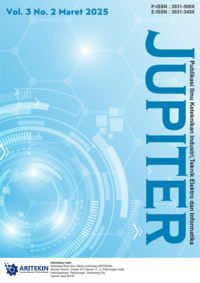Desain dan Implementasi Sistem Penyiraman Otomatis Berbasis IoT Menggunakan Mikrokontroler ESP
DOI:
https://doi.org/10.61132/jupiter.v3i2.762Keywords:
Internet of Things, Irrigation, MicrocontrollerAbstract
This research develops a prototype of an automatic watering device based on the Internet of Things (IoT) and a soil moisture sensor to improve the efficiency of watering crops in agricultural fields. The main problem addressed is the consistency and efficiency of watering in large agricultural fields, where traditional management is prone to human error and inefficient water use. The developed prototype uses an ESP8266 microcontroller (NodeMCU) as the brain of the system connected to a Wi-Fi network, allowing remote monitoring and control via the Blynk application. A soil moisture sensor is used to detect soil conditions in real-time, triggering watering only when needed. This helps optimize water use and increase agricultural productivity sustainably. This research outlines the methodological steps from design, manufacturing, to implementation of the prototype in the field. Evaluation of the results shows that the system successfully regulates watering effectively based on soil conditions, with positive responses from farmers as end users.
References
Abdelfattah, A. H., Sabirov, R. F., Ivanov, B. L., Lushnov, M. A., & Sabirov, R. A. (2020). Calibration of soil humidity sensors of automatic irrigation controller. BIO Web of Conferences, 17, 00249. https://doi.org/10.1051/bioconf/20201700249
Abdul-Qawy, A. S., Pramod, P. J., Magesh, E., & Srinivasulu, T. (2015). Internet of Things (IoT): An overview. International Institute of Engineers, 5(12), 71–82. https://doi.org/10.15242/iie.e0315045
Babiuch, M., Foltýnek, P., & Smutný, P. (2019). Using the ESP32 microcontroller for data processing. 2019 20th International Carpathian Control Conference (ICCC), 1–6. https://doi.org/10.1109/CarpathianCC.2019.8765944
Bolanakis, D. E. (2019). A survey of research in microcontroller education. Revista Iberoamericana de Tecnologías del Aprendizaje, 14(2), 50–57. https://doi.org/10.1109/RITA.2019.2922856
Hussain, A., Hammad, M., Hafeez, K., & Zainab, T. (2016). Programming a microcontroller. International Journal of Computer Applications, 155(5), 21–26. https://doi.org/10.5120/ijca2016912310
Ismailov, A. S. (2022). Study of Arduino microcontroller board. International Journal of Advanced Research, 3(3), 172–179.
Lee, I., & Lee, K. (2015). The Internet of Things (IoT): Applications, investments, and challenges for enterprises. Business Horizons, 58(4), 431–440. https://doi.org/10.1016/j.bushor.2015.03.008
Mahmoud, R., Yousuf, T., Aloul, F., & Zualkernan, I. (2016). Internet of Things (IoT) security: Current status, challenges, and prospective measures. 2015 10th International Conference for Internet Technology and Secured Transactions (ICITST), 336–341. https://doi.org/10.1109/ICITST.2015.7412116
Pangestu, A. D., Ardianto, F., & Alfaresi, B. (2019). Sistem monitoring beban listrik berbasis Arduino NodeMCU ESP8266. Jurnal Ampere, 4(1), 187. https://doi.org/10.31851/ampere.v4i1.2745
Rehman, A. U., Asif, R. M., Tariq, R., & Javed, A. (2017). GSM-based solar automatic irrigation system using moisture, temperature, and humidity sensors. 2017 International Conference on Engineering Technology and Technopreneurship (ICE2T 2017), 1–4. https://doi.org/10.1109/ICE2T.2017.8215945
Setiadi, D., & Abdul Muhaemin, M. N. (2018). Penerapan Internet of Things (IoT) pada sistem monitoring irigasi (Smart Irigasi). Infotronik: Jurnal Teknologi Informasi dan Elektronika, 3(2), 95. https://doi.org/10.32897/infotronik.2018.3.2.108
Sikarwar, S., & Yadav, B. C. (2015). Opto-electronic humidity sensor: A review. Sensors and Actuators A: Physical, 233, 54–70. https://doi.org/10.1016/j.sna.2015.05.007
Wu, Z., Qiu, K., & Zhang, J. (2020). A smart microcontroller architecture for the Internet of Things. Journal of Embedded Systems and Applications, 1, 1–17.
Downloads
Published
How to Cite
Issue
Section
License
Copyright (c) 2025 Jupiter: Publikasi Ilmu Keteknikan Industri, Teknik Elektro dan Informatika

This work is licensed under a Creative Commons Attribution-ShareAlike 4.0 International License.






